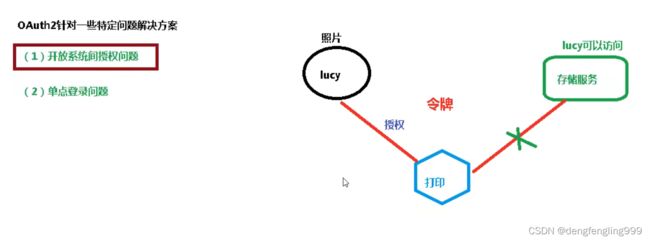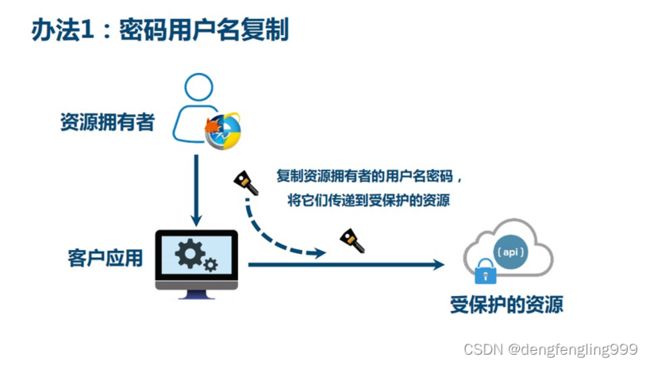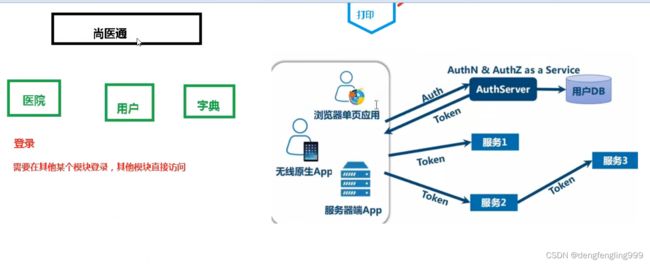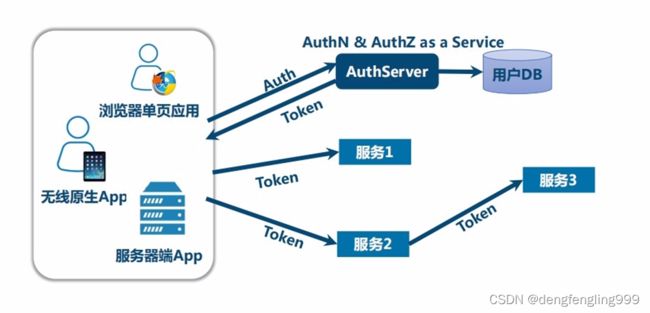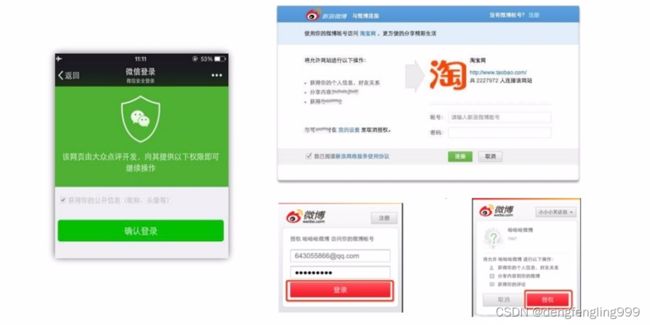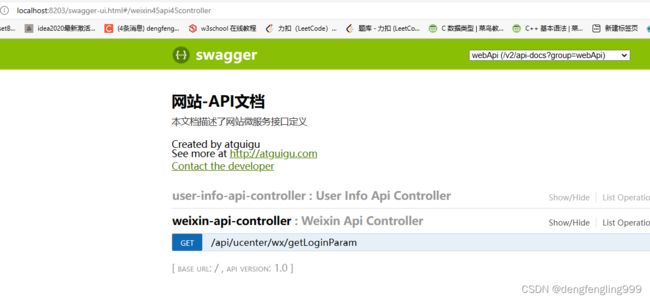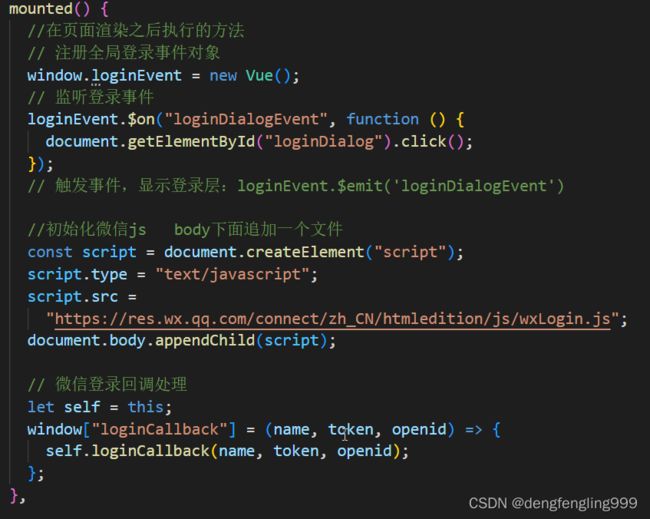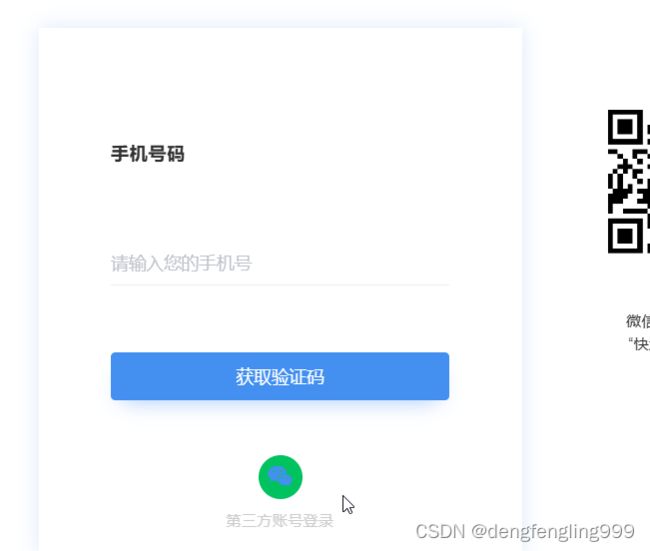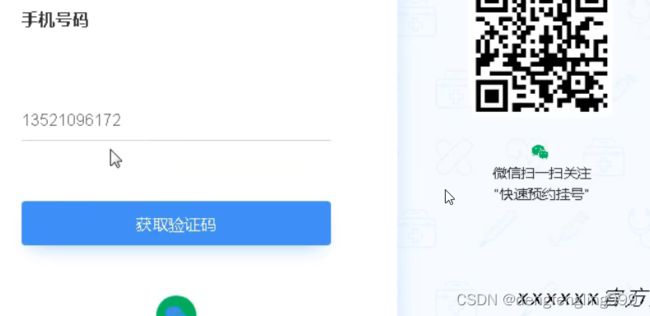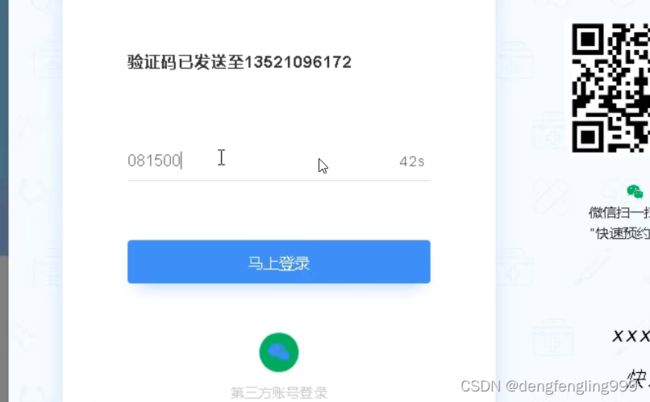尚医通-OAuth2-微信登录接口开发(三十一)
目录:
(1)微信登录-OAuth2介绍
(2)前台用户系统-微信登录-准备工作
(3)微信登录-生成微信二维码-接口开发
(4)微信登录-生成验证码-前端整合
(5)微信登录-获取扫码人信息-实现分析
(6)微信登录-获取联系人扫码信息-接口开发
(7)微信登录-手机号绑定和前端整合
(1)微信登录-OAuth2介绍
微信登录是基于理论知识OAuth2实现的
1、OAuth2
OAuth2解决什么问题
1.1.1 开放系统间授权
照片拥有者想要在云冲印服务上打印照片,云冲印服务需要访问云存储服务上的资源
资源拥有者:照片拥有者
客户应用:云冲印
受保护的资源:照片
1.1.3方式一:用户名密码复制
用户将自己的"云存储"服务的用户名和密码,告诉"云冲印",后者就可以读取用户的照片了。这样的做法有以下几个严重的缺点。
(1)"云冲印"为了后续的服务,会保存用户的密码,这样很不安全。
(2)Google不得不部署密码登录,而我们知道,单纯的密码登录并不安全。
(3)"云冲印"拥有了获取用户储存在Google所有资料的权力,用户没法限制"云冲印"获得授权的范围和有效期。
(4)用户只有修改密码,才能收回赋予"云冲印"的权力。但是这样做,会使得其他所有获得用户授权的第三方应用程序全部失效。
(5)只要有一个第三方应用程序被破解,就会导致用户密码泄漏,以及所有被密码保护的数据泄漏。
总结:
将受保护的资源中的用户名和密码存储在客户应用的服务器上,使用时直接使用这个用户名和密码登录
适用于同一公司内部的多个系统,不适用于不受信的第三方应用
1.1.4方式二:通用开发者key
适用于合作商或者授信的不同业务部门之间
1.1.5方式三:颁发令牌
接近OAuth2方式,需要考虑如何管理令牌、颁发令牌、吊销令牌,需要统一的协议,因此就有了OAuth2协议
使用令牌:字符串
令牌类比仆从钥匙
令牌:就是按照约定的规则,生成字符串,这个字符串颁发给某个服务,它它拿着进行访问,
设置字符串的有效时间,随时去吊销这个字符串,令牌的颁发我们令牌字符串我们需要对它进行加密等等处理
OAth2它只约定我们生成颁发令牌,生成字符串,但是字符串按照什么规则生成,它并没有约定,只告诉你用字符串方式解决,具体可以像之前的一个工具JWT工具生成字符串的的规则
OAth2只约定解决方案,并没有约定怎么去做,它只是颁发令牌、设置令牌的有效时间、包括随时去解除这个令牌
1.3 OAuth2的应用
1.3.1 微服务安全
现代微服务中系统微服务化以及应用的形态和设备类型增多,不能用传统的登录方式
核心的技术不是用户名和密码,而是token,由AuthServer颁发token,用户使用token进行登录
1.3.2 社交登录
(2)前台用户系统-微信登录-准备工作
点击微信扫码登录按钮,出现二维码,需要进行扫描,扫描二维码,获得扫码的信息,然后再出现绑定手机号,然后数据最后添加到数据库中
我们用到微信的相关操作,微信是腾讯开发的,需要调用腾讯那边的内容进行实现,需要先在微信的开放平台省注册一个用户,注册一个用户的目的就是让你有微信相关接口的权限,让他给你做一个授权,注册目前只支持企业级别的用户,个人用户不支持
2.1 前期准备
1、注册
微信开放平台:https://open.weixin.qq.com
2、邮箱激活
3、完善开发者资料
4、开发者资质认证
准备营业执照,1-2个工作日审批、300元
5、创建网站应用
提交审核,7个工作日审批
6、内网穿透
ngrok的使用
注册之后会提供一个id和秘钥,这里我们使用提供的,自己不在注册
redirect_url: 创建一个网站应用,在二维码下面显示,网站名称,这个名字需要微信那边审核通过
域名:扫码确认之后,完成扫码,完成扫码之后,得到扫码的信息,微信那端给我们做一个回调,扫码之后,会调用指定接口的路径,这个路径我们没有办法调用本地,默认找不到,需要找到一个网络返回的的域名,才能返回,这就需要一个能够返回的域名
获取access_token时序图
第一步:请求CODE(生成授权URL)
第二步:通过code获取access_token(开发回调URL)
在service_user模块中添加:微信的配置
创建一个工具类读取配置文件刚才配置的内容:
package com.atguigu.yygh.user.utils;
import org.springframework.beans.factory.InitializingBean;
import org.springframework.beans.factory.annotation.Value;
import org.springframework.stereotype.Component;
@Component
public class ConstantWxPropertiesUtils implements InitializingBean {
@Value("${wx.open.app_id}")
private String appId;
@Value("${wx.open.app_secret}")
private String appSecret;
@Value("${wx.open.redirect_url}")
private String redirectUrl;
@Value("${yygh.baseUrl}")
private String yyghBaseUrl;
public static String WX_OPEN_APP_ID;
public static String WX_OPEN_APP_SECRET;
public static String WX_OPEN_REDIRECT_URL;
public static String YYGH_BASE_URL;
@Override
public void afterPropertiesSet() throws Exception {
WX_OPEN_APP_ID = appId;
WX_OPEN_APP_SECRET = appSecret;
WX_OPEN_REDIRECT_URL = redirectUrl;
YYGH_BASE_URL = yyghBaseUrl;
}
}
创建controller:WeixinApiController
package com.atguigu.yygh.user.api;
import org.springframework.stereotype.Controller;
import org.springframework.web.bind.annotation.RequestMapping;
//微信操作的接口
@Controller
@RequestMapping("/api/ucenter/wx")
public class WeixinApiController {
//1 生成微信扫描的二维码
//2 回调的方法,得到扫描人的信息
}
(3)微信登录-生成微信二维码-接口开发
操作模块:service-user
说明:微信登录二维码我们是以弹出层的形式打开,不是以页面形式,所以做法是不一样的,参考如下链接,上面有相关弹出层的方式
准备工作 | 微信开放文档微信开发者平台文档![]() https://developers.weixin.qq.com/doc/oplatform/Website_App/WeChat_Login/Wechat_Login.html
https://developers.weixin.qq.com/doc/oplatform/Website_App/WeChat_Login/Wechat_Login.html
如图:
因此我们的操作步骤为:
第一步我们通过接口把对应参数返回页面;
第二步在头部页面启动打开微信登录二维码;
第三步处理登录回调接口;
第四步回调返回页面通知微信登录层回调成功
第五步如果是第一次扫描登录,则绑定手机号码,登录成功
接下来我们根据步骤,一步一步实现
接下来我们写接口返回参数:
在:WeixinApiController :中添加方法:
package com.atguigu.yygh.user.api;
import com.atguigu.yygh.common.result.Result;
import com.atguigu.yygh.user.utils.ConstantWxPropertiesUtils;
import org.springframework.stereotype.Controller;
import org.springframework.web.bind.annotation.GetMapping;
import org.springframework.web.bind.annotation.RequestMapping;
import org.springframework.web.bind.annotation.ResponseBody;
import javax.servlet.http.HttpSession;
import java.io.UnsupportedEncodingException;
import java.net.URLEncoder;
import java.util.HashMap;
import java.util.Map;
//微信操作的接口
@Controller
@RequestMapping("/api/ucenter/wx")
public class WeixinApiController {
//1 生成微信扫描的二维码
//返回生成二维码需要的参数
@GetMapping("getLoginParam")
@ResponseBody
public Result genQrConnect(HttpSession session) throws UnsupportedEncodingException {
Map map = new HashMap<>();
map.put("appid", ConstantWxPropertiesUtils.WX_OPEN_APP_ID);
String redirectUri = URLEncoder.encode(ConstantWxPropertiesUtils.WX_OPEN_REDIRECT_URL, "UTF-8");
map.put("redirectUri", redirectUri);
map.put("scope", "snsapi_login");
map.put("state", System.currentTimeMillis()+"");//System.currentTimeMillis()+""
return Result.ok(map);
}
//2 回调的方法,得到扫描人的信息
}
(4)微信登录-生成验证码-前端整合
参数成功返回:
创建weixin.js:
import request from '@/utils/request'
const api_name = `/api/ucenter/wx`
export default {
getLoginParam() {
return request({
url: `${api_name}/getLoginParam`,
method: `get`
})
}
}
在myheader.vue中引入这个js:
在mounted里面添加初始化微信js
书写点击微信Login方法
在网关加上这个访问的路径:
测试点击如果验证码没有出来,修改配置文件:
点击下方的微信登录:出现二维码:
微信那段扫描我们的二维码,微信那端会回调咱的方法,咱的方法中会得到扫码人的信息,把信息加到数据库中,在这过程中微信要给它绑定一个手机号最终完成操作
(5)微信登录-获取扫码人信息-实现分析
修改service_user模块的端口号:8106
(6)微信登录-获取联系人扫码信息-接口开发
 httpclient请求微信提供的地址,原来是在地址栏输入地址回车请求,目前是程序中做到,不是用浏览器请求,所以用到这个技术,可以简单理解为不需要浏览器,帮助我们请求地址,然后得到地址返回的数据,或得到请求接口返回的数据,这就叫httpclient模拟浏览器请求和响应的过程
httpclient请求微信提供的地址,原来是在地址栏输入地址回车请求,目前是程序中做到,不是用浏览器请求,所以用到这个技术,可以简单理解为不需要浏览器,帮助我们请求地址,然后得到地址返回的数据,或得到请求接口返回的数据,这就叫httpclient模拟浏览器请求和响应的过程
在common-util中引入依赖:
创建工具类:HttpClientUtils
package com.atguigu.yygh.user.utils;
import org.apache.commons.io.IOUtils;
import org.apache.commons.lang.StringUtils;
import org.apache.http.Consts;
import org.apache.http.HttpEntity;
import org.apache.http.HttpResponse;
import org.apache.http.NameValuePair;
import org.apache.http.client.HttpClient;
import org.apache.http.client.config.RequestConfig;
import org.apache.http.client.config.RequestConfig.Builder;
import org.apache.http.client.entity.UrlEncodedFormEntity;
import org.apache.http.client.methods.HttpGet;
import org.apache.http.client.methods.HttpPost;
import org.apache.http.conn.ConnectTimeoutException;
import org.apache.http.conn.ssl.SSLConnectionSocketFactory;
import org.apache.http.conn.ssl.SSLContextBuilder;
import org.apache.http.conn.ssl.TrustStrategy;
import org.apache.http.conn.ssl.X509HostnameVerifier;
import org.apache.http.entity.ContentType;
import org.apache.http.entity.StringEntity;
import org.apache.http.impl.client.CloseableHttpClient;
import org.apache.http.impl.client.HttpClients;
import org.apache.http.impl.conn.PoolingHttpClientConnectionManager;
import org.apache.http.message.BasicNameValuePair;
import javax.net.ssl.SSLContext;
import javax.net.ssl.SSLException;
import javax.net.ssl.SSLSession;
import javax.net.ssl.SSLSocket;
import java.io.IOException;
import java.net.SocketTimeoutException;
import java.security.GeneralSecurityException;
import java.security.cert.CertificateException;
import java.security.cert.X509Certificate;
import java.util.ArrayList;
import java.util.List;
import java.util.Map;
import java.util.Map.Entry;
import java.util.Set;
public class HttpClientUtils {
public static final int connTimeout=10000;
public static final int readTimeout=10000;
public static final String charset="UTF-8";
private static HttpClient client = null;
static {
PoolingHttpClientConnectionManager cm = new PoolingHttpClientConnectionManager();
cm.setMaxTotal(128);
cm.setDefaultMaxPerRoute(128);
client = HttpClients.custom().setConnectionManager(cm).build();
}
public static String postParameters(String url, String parameterStr) throws ConnectTimeoutException, SocketTimeoutException, Exception{
return post(url,parameterStr,"application/x-www-form-urlencoded",charset,connTimeout,readTimeout);
}
public static String postParameters(String url, String parameterStr,String charset, Integer connTimeout, Integer readTimeout) throws ConnectTimeoutException, SocketTimeoutException, Exception{
return post(url,parameterStr,"application/x-www-form-urlencoded",charset,connTimeout,readTimeout);
}
public static String postParameters(String url, Map params) throws ConnectTimeoutException,
SocketTimeoutException, Exception {
return postForm(url, params, null, connTimeout, readTimeout);
}
public static String postParameters(String url, Map params, Integer connTimeout,Integer readTimeout) throws ConnectTimeoutException,
SocketTimeoutException, Exception {
return postForm(url, params, null, connTimeout, readTimeout);
}
public static String get(String url) throws Exception {
return get(url, charset, null, null);
}
public static String get(String url, String charset) throws Exception {
return get(url, charset, connTimeout, readTimeout);
}
/**
* 发送一个 Post 请求, 使用指定的字符集编码.
*
* @param url
* @param body RequestBody
* @param mimeType 例如 application/xml "application/x-www-form-urlencoded" a=1&b=2&c=3
* @param charset 编码
* @param connTimeout 建立链接超时时间,毫秒.
* @param readTimeout 响应超时时间,毫秒.
* @return ResponseBody, 使用指定的字符集编码.
* @throws ConnectTimeoutException 建立链接超时异常
* @throws SocketTimeoutException 响应超时
* @throws Exception
*/
public static String post(String url, String body, String mimeType,String charset, Integer connTimeout, Integer readTimeout)
throws ConnectTimeoutException, SocketTimeoutException, Exception {
HttpClient client = null;
HttpPost post = new HttpPost(url);
String result = "";
try {
if (StringUtils.isNotBlank(body)) {
HttpEntity entity = new StringEntity(body, ContentType.create(mimeType, charset));
post.setEntity(entity);
}
// 设置参数
RequestConfig.Builder customReqConf = RequestConfig.custom();
if (connTimeout != null) {
customReqConf.setConnectTimeout(connTimeout);
}
if (readTimeout != null) {
customReqConf.setSocketTimeout(readTimeout);
}
post.setConfig(customReqConf.build());
HttpResponse res;
if (url.startsWith("https")) {
// 执行 Https 请求.
client = createSSLInsecureClient();
res = client.execute(post);
} else {
// 执行 Http 请求.
client = HttpClientUtils.client;
res = client.execute(post);
}
result = IOUtils.toString(res.getEntity().getContent(), charset);
} finally {
post.releaseConnection();
if (url.startsWith("https") && client != null&& client instanceof CloseableHttpClient) {
((CloseableHttpClient) client).close();
}
}
return result;
}
/**
* 提交form表单
*
* @param url
* @param params
* @param connTimeout
* @param readTimeout
* @return
* @throws ConnectTimeoutException
* @throws SocketTimeoutException
* @throws Exception
*/
public static String postForm(String url, Map params, Map headers, Integer connTimeout,Integer readTimeout) throws ConnectTimeoutException,
SocketTimeoutException, Exception {
HttpClient client = null;
HttpPost post = new HttpPost(url);
try {
if (params != null && !params.isEmpty()) {
List formParams = new ArrayList();
Set> entrySet = params.entrySet();
for (Entry entry : entrySet) {
formParams.add(new BasicNameValuePair(entry.getKey(), entry.getValue()));
}
UrlEncodedFormEntity entity = new UrlEncodedFormEntity(formParams, Consts.UTF_8);
post.setEntity(entity);
}
if (headers != null && !headers.isEmpty()) {
for (Entry entry : headers.entrySet()) {
post.addHeader(entry.getKey(), entry.getValue());
}
}
// 设置参数
Builder customReqConf = RequestConfig.custom();
if (connTimeout != null) {
customReqConf.setConnectTimeout(connTimeout);
}
if (readTimeout != null) {
customReqConf.setSocketTimeout(readTimeout);
}
post.setConfig(customReqConf.build());
HttpResponse res = null;
if (url.startsWith("https")) {
// 执行 Https 请求.
client = createSSLInsecureClient();
res = client.execute(post);
} else {
// 执行 Http 请求.
client = HttpClientUtils.client;
res = client.execute(post);
}
return IOUtils.toString(res.getEntity().getContent(), "UTF-8");
} finally {
post.releaseConnection();
if (url.startsWith("https") && client != null
&& client instanceof CloseableHttpClient) {
((CloseableHttpClient) client).close();
}
}
}
/**
* 发送一个 GET 请求
*/
public static String get(String url, String charset, Integer connTimeout,Integer readTimeout)
throws ConnectTimeoutException,SocketTimeoutException, Exception {
HttpClient client = null;
HttpGet get = new HttpGet(url);
String result = "";
try {
// 设置参数
Builder customReqConf = RequestConfig.custom();
if (connTimeout != null) {
customReqConf.setConnectTimeout(connTimeout);
}
if (readTimeout != null) {
customReqConf.setSocketTimeout(readTimeout);
}
get.setConfig(customReqConf.build());
HttpResponse res = null;
if (url.startsWith("https")) {
// 执行 Https 请求.
client = createSSLInsecureClient();
res = client.execute(get);
} else {
// 执行 Http 请求.
client = HttpClientUtils.client;
res = client.execute(get);
}
result = IOUtils.toString(res.getEntity().getContent(), charset);
} finally {
get.releaseConnection();
if (url.startsWith("https") && client != null && client instanceof CloseableHttpClient) {
((CloseableHttpClient) client).close();
}
}
return result;
}
/**
* 从 response 里获取 charset
*/
@SuppressWarnings("unused")
private static String getCharsetFromResponse(HttpResponse ressponse) {
// Content-Type:text/html; charset=GBK
if (ressponse.getEntity() != null && ressponse.getEntity().getContentType() != null && ressponse.getEntity().getContentType().getValue() != null) {
String contentType = ressponse.getEntity().getContentType().getValue();
if (contentType.contains("charset=")) {
return contentType.substring(contentType.indexOf("charset=") + 8);
}
}
return null;
}
/**
* 创建 SSL连接
* @return
* @throws GeneralSecurityException
*/
private static CloseableHttpClient createSSLInsecureClient() throws GeneralSecurityException {
try {
SSLContext sslContext = new SSLContextBuilder().loadTrustMaterial(null, new TrustStrategy() {
public boolean isTrusted(X509Certificate[] chain,String authType) throws CertificateException {
return true;
}
}).build();
SSLConnectionSocketFactory sslsf = new SSLConnectionSocketFactory(sslContext, new X509HostnameVerifier() {
@Override
public boolean verify(String arg0, SSLSession arg1) {
return true;
}
@Override
public void verify(String host, SSLSocket ssl)
throws IOException {
}
@Override
public void verify(String host, X509Certificate cert)
throws SSLException {
}
@Override
public void verify(String host, String[] cns,
String[] subjectAlts) throws SSLException {
}
});
return HttpClients.custom().setSSLSocketFactory(sslsf).build();
} catch (GeneralSecurityException e) {
throw e;
}
}
}
UserInfoService 接口:
package com.atguigu.yygh.user.service;
import com.atguigu.yygh.model.user.UserInfo;
import com.atguigu.yygh.vo.user.LoginVo;
import com.baomidou.mybatisplus.extension.service.IService;
import java.util.Map;
public interface UserInfoService extends IService {
//用户手机登录接口
Map login(LoginVo loginVo);
//根据openid判断数据库是否存在微信的扫描人信息
UserInfo selectWxInfoOpenId(String openid);
}
实现类: UserInfoServiceImpl:添加实现方法:
在WexinApiController:微信扫码回调方法
package com.atguigu.yygh.user.api;
import com.alibaba.fastjson.JSONObject;
import com.atguigu.yygh.common.helper.JwtHelper;
import com.atguigu.yygh.common.result.Result;
import com.atguigu.yygh.model.user.UserInfo;
import com.atguigu.yygh.user.service.UserInfoService;
import com.atguigu.yygh.user.utils.ConstantWxPropertiesUtils;
import com.atguigu.yygh.user.utils.HttpClientUtils;
import org.springframework.beans.factory.annotation.Autowired;
import org.springframework.stereotype.Controller;
import org.springframework.util.StringUtils;
import org.springframework.web.bind.annotation.GetMapping;
import org.springframework.web.bind.annotation.RequestMapping;
import org.springframework.web.bind.annotation.ResponseBody;
import javax.servlet.http.HttpSession;
import java.io.UnsupportedEncodingException;
import java.net.URLEncoder;
import java.util.HashMap;
import java.util.Map;
//微信操作的接口
@Controller
@RequestMapping("/api/ucenter/wx")
public class WeixinApiController {
@Autowired
private UserInfoService userInfoService;
//1 生成微信扫描的二维码
//返回生成二维码需要的参数
@GetMapping("getLoginParam")
@ResponseBody
public Result genQrConnect(HttpSession session) throws UnsupportedEncodingException {
Map map = new HashMap<>();
map.put("appid", ConstantWxPropertiesUtils.WX_OPEN_APP_ID);
String redirect_Uri = URLEncoder.encode(ConstantWxPropertiesUtils.WX_OPEN_REDIRECT_URL, "UTF-8");
map.put("redirect_Uri", redirect_Uri);
map.put("scope", "snsapi_login");
map.put("state", System.currentTimeMillis()+"");//System.currentTimeMillis()+""
return Result.ok(map);
}
//微信扫描后回调的方法
@GetMapping("callback") //code和state是回调函数请求过来的时候携带的2个参数
public String callback(String code,String state) {
//第一步 获取临时票据 code
System.out.println("code:"+code);
//第二步 拿着code和微信id和秘钥,请求微信固定地址 ,得到两个值
//使用code和appid以及appscrect换取access_token字符串
// %s 占位符
StringBuffer baseAccessTokenUrl = new StringBuffer()
.append("https://api.weixin.qq.com/sns/oauth2/access_token")
.append("?appid=%s")
.append("&secret=%s")
.append("&code=%s")
.append("&grant_type=authorization_code");
String accessTokenUrl = String.format(baseAccessTokenUrl.toString(),
ConstantWxPropertiesUtils.WX_OPEN_APP_ID,
ConstantWxPropertiesUtils.WX_OPEN_APP_SECRET,
code);
//使用httpclient请求这个地址
try {
String accesstokenInfo = HttpClientUtils.get(accessTokenUrl);
System.out.println("accesstokenInfo:"+accesstokenInfo);
//从返回字符串获取两个值 openid 和 access_token
JSONObject jsonObject = JSONObject.parseObject(accesstokenInfo);
String access_token = jsonObject.getString("access_token");
String openid = jsonObject.getString("openid");
//判断数据库是否存在微信的扫描人信息
//根据openid判断
UserInfo userInfo = userInfoService.selectWxInfoOpenId(openid);
if(userInfo == null) { //数据库不存在微信信息
//第三步 拿着openid 和 access_token请求微信地址,得到扫描人信息
String baseUserInfoUrl = "https://api.weixin.qq.com/sns/userinfo" +
"?access_token=%s" +
"&openid=%s";
String userInfoUrl = String.format(baseUserInfoUrl, access_token, openid);
String resultInfo = HttpClientUtils.get(userInfoUrl);
System.out.println("resultInfo:"+resultInfo);
JSONObject resultUserInfoJson = JSONObject.parseObject(resultInfo);
//解析用户信息
//用户昵称
String nickname = resultUserInfoJson.getString("nickname");
//用户头像
String headimgurl = resultUserInfoJson.getString("headimgurl");
//获取扫描人信息添加数据库
userInfo = new UserInfo();
userInfo.setNickName(nickname);
userInfo.setOpenid(openid);
userInfo.setStatus(1);
userInfoService.save(userInfo);
}
//返回name和token字符串
Map map = new HashMap<>();
String name = userInfo.getName();
if(StringUtils.isEmpty(name)) {
name = userInfo.getNickName();
}
if(StringUtils.isEmpty(name)) {
name = userInfo.getPhone();
}
map.put("name", name);
//判断userInfo是否有手机号,如果手机号为空,返回openid
//如果手机号不为空,返回openid值是空字符串
//前端判断:如果openid不为空,绑定手机号,如果openid为空,不需要绑定手机号
if(StringUtils.isEmpty(userInfo.getPhone())) {
map.put("openid", userInfo.getOpenid());
} else {
map.put("openid", "");
}
//使用jwt生成token字符串
String token = JwtHelper.createToken(userInfo.getId(), name);
map.put("token", token);
//跳转到前端页面
return "redirect:" + ConstantWxPropertiesUtils.YYGH_BASE_URL + "/weixin/callback?token="+map.get("token")+ "&openid="+map.get("openid")+"&name="+URLEncoder.encode(map.get("name"),"utf-8");
} catch (Exception e) {
e.printStackTrace();
return null;
}
}
}
(7)微信登录-手机号绑定和前端整合
创建weixin callback.vue
这是一个中转页面,得到参数值,再调用弹框里面的方法,一会在myheader弹框中写上这个回调方法loginCallback,callback做一个中转页面,由页面在跳到弹框里面更加方便
在myheader.vue中添加:
myheader.vue详细代码:
 尚医通 预约挂号统一平台
尚医通 预约挂号统一平台
搜索
帮助中心
登录/注册
{{ name }}
实名认证
挂号订单
就诊人管理
退出登录
然后修改一下手机登录的部分,我们把微信登录跟手机号绑定写到一起,微信扫描之后还是进入手机的登录页面
修改UserInfoServiceImpl:的手机登录
//用户手机登录接口
@Override
public Map login(LoginVo loginVo) {
//从loginVo里面获取输入的手机号和验证码
String phone = loginVo.getPhone();
String code = loginVo.getCode();
//校验参数 判断手机号和验证码是否为空
if(StringUtils.isEmpty(phone) || StringUtils.isEmpty(code)) {
throw new HospitalException(ResultCodeEnum.PARAM_ERROR);
}
//(整合阿里云短信服务)判断手机验证码和输入的验证码是否一致
//校验校验验证码
String mobleCode = redisTemplate.opsForValue().get(phone);
if(!code.equals(mobleCode)) {
throw new HospitalException(ResultCodeEnum.CODE_ERROR);
}
//绑定手机号码
UserInfo userInfo = null;
if(!StringUtils.isEmpty(loginVo.getOpenid())) {
userInfo = this.selectWxInfoOpenId(loginVo.getOpenid());
if(null != userInfo) {
userInfo.setPhone(loginVo.getPhone());
this.updateById(userInfo);
} else {
throw new HospitalException(ResultCodeEnum.DATA_ERROR);
}
}
//如果userInf为空做的是正常的手机登录
if (userInfo==null){
//判断是否是第一次登录:根据手机号查询数据库,如果不存在相同的手机号就是第一次登录
QueryWrapper queryWrapper = new QueryWrapper<>();
queryWrapper.eq("phone", phone);
userInfo = baseMapper.selectOne(queryWrapper);
if(null == userInfo) {//等于空表示第一次使用这个手机号登录
userInfo = new UserInfo();
userInfo.setName("");
userInfo.setPhone(phone);
userInfo.setStatus(1);
baseMapper.insert(userInfo);
}
}
//校验是否被禁用
if(userInfo.getStatus() == 0) {//判断用户状态是否为0禁用状态
throw new HospitalException(ResultCodeEnum.LOGIN_DISABLED_ERROR);
}
//不是第一次登录,直接登陆
//返回登录的信息 :返回用户名 返回tocken信息
Map map = new HashMap<>();
String name = userInfo.getName();
if(StringUtils.isEmpty(name)) {
name = userInfo.getNickName();
}
if(StringUtils.isEmpty(name)) {
name = userInfo.getPhone();
}
map.put("name", name);
//JWT工具类生成token
String token = JwtHelper.createToken(userInfo.getId(), name);
map.put("token", token);
return map;
} 点击登录:
点击第三方账号登录:
用手机扫描二维码:
yygh_user数据库表user_nfo成功插入一条数据:
这页面换成了昵称显示登录:
